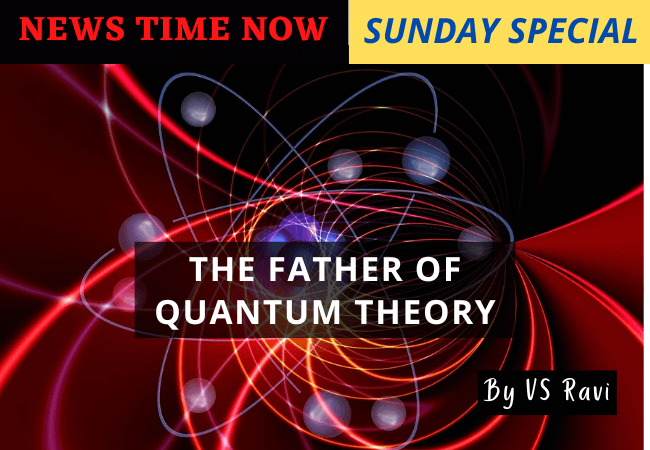Twentieth century physics can be divided into two parts- Relativity and Quantum Mechanics. Relativity is the result of the work of one man, Albert Einstein. Quantum Mechanics is the result of the work of several physicists – Max Planck, Werner Heisenberg, Neils Bohr, Paul Dirac, Erwin Schrödinger, Richard Feynman, (all of whom are Nobel Laureates) and several others.
Planck was born on April 28, 1858. He was born in Kiel, a port on the Baltic Sea. Of German ancestry, Planck’ father was a well-known professor of constitutional law who helped write the Prussian Civil Code: Educated at the Maximilian- Gymnasium Planck was an excellent but not outstanding student. However he became interested in physics, entered the University of Munich in 1874, and received his Ph.D.
There is an anecdote (probably apocryphal) that when he approached a professor in Physics in 1879 to seek his opinion about taking up a career in physics, the professor dissuaded him saying there was nothing left in physics to study. This was shortly before Physics was shaken to its foundations by Relativity and Quantum Mechanics!
His doctoral dissertation concerned the second law of Thermodynamics and indicates Planck’s fascination with fundamental problems. The prospect that the outside world was something “absolute” challenged him, and he wrote, “the quest for the laws which apply to this absolute appeared to me as the most sublime scientific pursuit in life.” After a period of teaching at the universities of Munich and Kiel, Planck became a professor at the University of Berlin in 1889. There he did the bulk of his work, and remained there until 1928.
The discovery of the quantum, related to the problem of “blackbody radiation,”, which vexed physicists in the late nineteenth century, and interested Planck just because of its fundamental significance. In 1859 Gustavia Kircchoff had discovered that the quality of heat radiated by any object was dependent only on temperature and wavelength and not on the nature of the object itself. Some universal function was therefore at work. Examining how a “blackbody” would emit radiation, physicists came upon a disturbing result. By classical law, radiation from something which absorbed all radiation ought also to radiate heat and light in infinite amounts, with greatest intensity at the shortest, invisible, ultraviolet wavelengths. But experiment showed this was not the case.
Light emitted from a heated cavity–a furnace, for example- gives off a spectral range of colours from bright yellow to red to blue-white and to the hottest, “white heat.” Classical physics could not predict this spectrum. Sometimes called the “ultraviolet catastrophe” because of the wide disagreement of prediction to experiment at the shortest wavelengths, the problem of blackbody radiation was not a minor issue in the nineteenth century physics. It posed a great challenge to the first law of thermodynamics, which describes heat as a form of energy and states that like mechanical energy, thermal energy is converted not created or destroyed .
After several false starts, beginning in 1897, Planck succeeded in finding a formula for physical theory, predicting black body radiation. Essentially he gave up the underlying classical notion that light and heat would be emitted in a steady stream. Rather energy is radiated in discrete units or bundles.Planck discovered a universal constant which could be used to compute the observed spectrum . Although Planck’s explanation founded solidly on physics theory, ” Planck’s constant’ as this number became known, was the result of intense effort and fortunate guess. A very small number h- representing a tiny quantity of energy multiplied by an infinitesimal amount of time- Planck called an ” elementary quantum of action”. It allowed for theoretical equations which agreed with the observable range of spectral phenomena. Effectively, the gathering vibrations in a heated cavity radiate heat only at certain, definite energies, of which the quantum is the smallest unit. There are no fractional quanta- no h/2 for example.
Planck published his first paper on the quantum in December 1900, inaugurating quantum physics .
The significance of Planck’s constant proved to be fundamental when it was generalised as the law of blackbody radiation.
Although it violated classical physics and baffled physicists, it was accepted because it agreed with experimental results. Then in 1905, Einstein used the quantum as a theoretical tool to explain the photoelectric effect, showing how light can sometimes behave as a stream of particles. Ironically Einstein was awarded the Nobel Prize for his explanation of photoelectric effect and not for Relativity. Not long thereafter, in 1913, Niels Bohr took advantage of the larger implications of Planck’s approach in developing his model of the atom. Instead of applying classical principles which conceived of the atom as a sort of miniature solar system, Bohr’s model of the atom would now be viewed as a system in which electrons operated only in orbits with certain values, quantised by using Planck’s constant.
In 1919 Planck was awarded the Nobel Prize.
In 1928 he left the university of Berlin. Two years later he became president of the Kaiser Wilhelm Society. Although the society was later renamed in his honour, he was forced out of it during the Hitler era when he courted considerable danger by criticising the Nazis. During the 1930s he published several works including the Introduction to Theoretical Physics in five volumes and Philosophy of Physics.
Planck was an excellent musician who sometimes was accompanied on the violin by Einstein.
His life was not devoid of tragedy. With his first wife he had four children. He lost two daughters soon after their marriage both to complications in child birth. One of his sons was killed in World War I . His other son lived to adulthood but was involved in a failed plot to kill Hitler; he was executed.
Planck’s second wife was his first wife’s niece.
At the end of World War II, Planck’s home and virtually all his papers were destroyed in Allied bombing. He was quite religious believing to the end of his life in a beneficent Almighty.
He died on December 4, 1947.
Abraham Pais has called him “a traditional figure par excellence”
It ought to be pointed out that it is rather ironical that Planck was never entirely reconciled with the implications of his own brainchild quantum theory- especially with the uncertainty principle and limitations of causality introduced in the 1920s. These developments, which entailed basic changes in physicists’ thinking about fundamental issues were difficult for him and many others including Einstein to accept.
Emilio Segre, wrote about Max Planck “he found himself compelled by the strength of factual evidence and logic rigour to promote one of the greatest revolutions in natural philosophy”.
Planck is truly one of the all time greats of Physics. Many scientists hold the view that in history’s Hall of Fame Max Planck stands alongside, Copernicus, Newton, Darwin, and Einstein.


















































